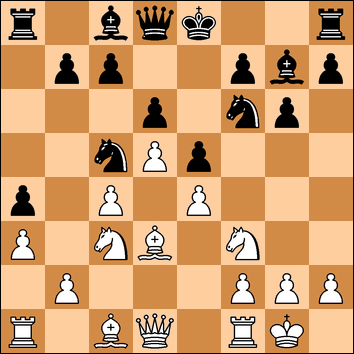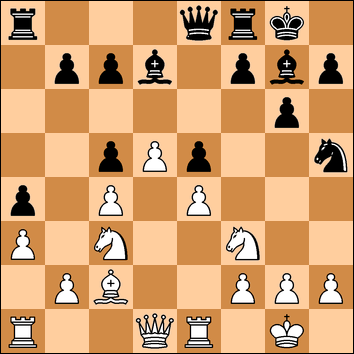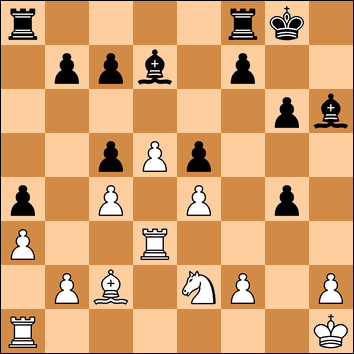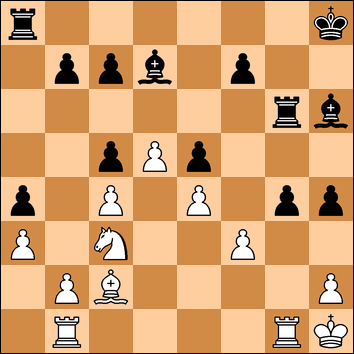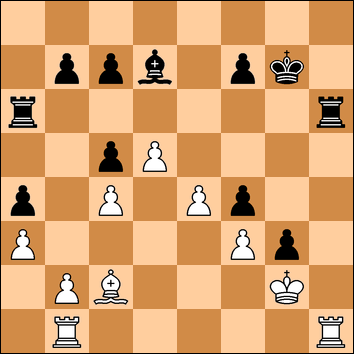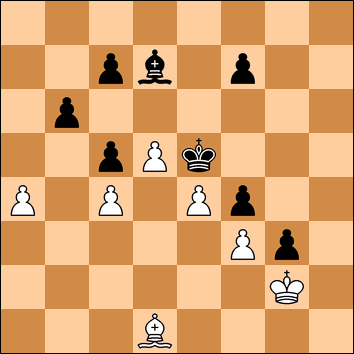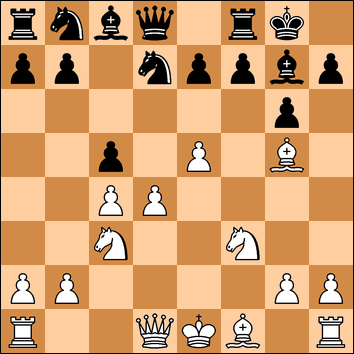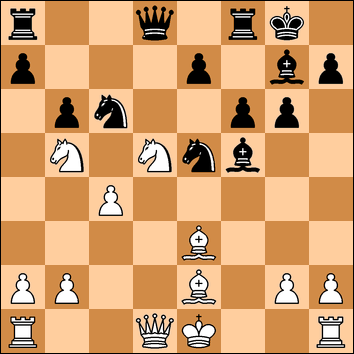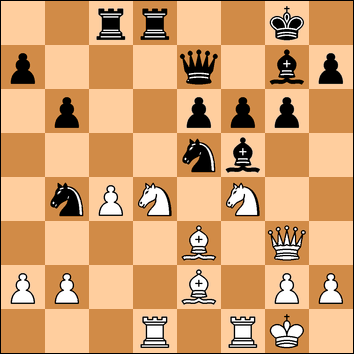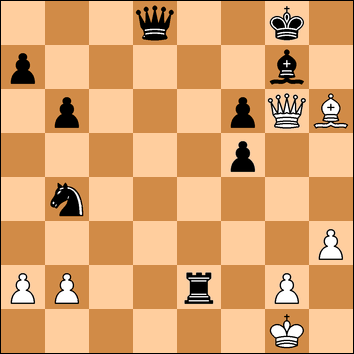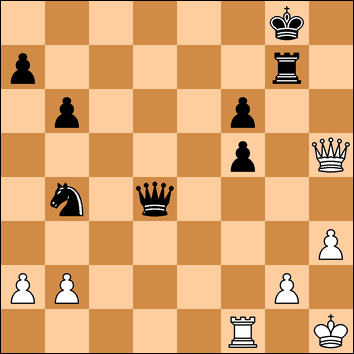Thursday 29 September 2016
White: K. Nevols (134) - Black: K. Hyde (167)
Another game against one of the top two and hoping to improve on my record of half out of four.
Having got nowhere with the Closed Sicilian in our last encounter, I decided to return to d4 for a change.
1. d4 Nf6
2. c4 g6
3. Nc3 d5
The Grunfeld Defence. I decide again to enter the Exchange Nf3+Rb1 variation.
4. cxd5 exd5
5. e4 Nxc3
6. bxc3 Bg7
7. Nf3 O-O
Usual is 7. .. c5 for Black so that he has the option of Nc6 straight away afterwards.
8. Rb1
The computer prefers 8. Bc4 and then castling. The purpose of Rb1 is to take the rook off the diagonal and also to hold up Blacks' development of his queen bishop by the attack on the b pawn.
8. ... c5
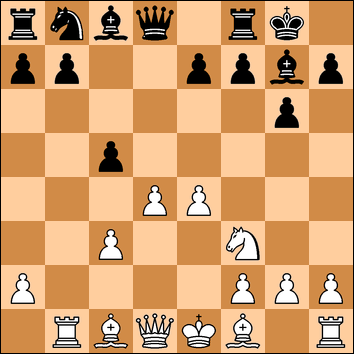
Now the main line of the system (which I forgot at the time) is 9. Be2 cxd4 10. cxd4 Qa5+ 11. Bd2 Qxa2 12. O-O. White sacrifices a pawn in order to get active play around d5. Black's best is now considered to be 12. .. Bg4 when White plays 13. Be3 Nc6 14. d5 or 13. Bg5.
9. Be3 cxd4
10. cxd4 Qa5+
The problem now is that if 11. Bd2 Qxa2 White does not have the option of castling and has wasted a tempo. But I was not going to sacrifice a pawn against such a dangerous opponent anyway.
11. Qd2 Qxd2+
12. Kxd2?!
However, without queens, the King is quite safe in the centre (or so I thought!) Although a waste of time, 12. Bxd2 might have been wiser.
12. .... Nc6
13. Bc4
An immediate 13. d5 is better. If then 13. .. Rd8 then 14. Bd3 completes White's development.
13. ... Rd8
14. d5 e6
Black begins to undermine White's centre in Grunfeld style. I was now trying to think of how I can get the other rook into the game, and move the king into safety, without losing a pawn.
15. Ke2?
And this is a mistake. 15. Bg5 should be played. If 15. .. f6 the diagonal from c4 to Black's king is weakened and White could play 16. Bf4 with an idea of coming to c7, and 15. .. Rd7 just looks ugly.
15. ... Na5
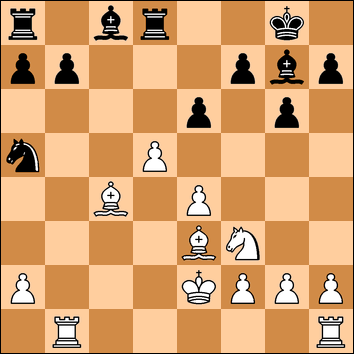
Now I knew the game was up and had a long think. I am going to lose a pawn but how can I get a lot of play over it? I looked at 16. Bb3 Nxb3 17. Rxb3 exd5 18. exd5 Rxd5 19. Rc1 but then after 19 .. b6 with the threat of Ba6+, it is Black who has the strong position.
The computer suggests 16. Bd3 exd5 17. exd5 Rxd5 18. Be4 Rd8 19. Rfc1 and then Be6 20. Bxb7 Nxb7 21. Rxb7 Bxa2 22. Rxa7 Bd5. This equalises the material but Black has strong bishops and White's king is in the centre.
I did not see the 18. Be4 option. Instead I thought I saw a way to get counterplay by bringing the rook to the seventh rank with Ng5.
16. Rhc1 Nxc4
17. Rxc4
White now has 46 minutes left to get to move 35 and Black has 39 minutes. The time was not a problem in this game.
17. .... exd5
18. exd5
This was the position that had been in my head. Now 18. .. Rxd5 19. Rc7 with Ng5 had been the plan. I now saw the possibility of 19. Bxa7 but then that loses to 19. .. Bf5.
However, Black opts to delay taking the pawn and finish the queenside development.
18. .... b6
I looked at 19. Rc7 but I was concerned about 19. .. Ba6+ which would have trapped the king in the centre.
19. Ra4 Bf5
20. Rc1 Rxd5
21. Bxb6
Material is now equal but with the rampant bishops and the king in the centre, Black is a long way ahead. I must try to exchange off one of the enemy bishops.
21. ... Re8+
22. Be3 a5
Now Black is much better with very active rooks and bishops and my king in the centre. I have to think of a defence. Trying to make the king safe and unpin the bishop seems to be a good idea.
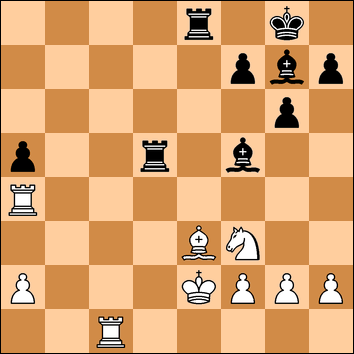
23. Kf1?
But a better move would have been 23. Rd1. My opponent pointed out afterwards that it was a mistake to allow the rooks to double up on the d-file.
The move I was now concerned about was 23. .. Bd7 when my rook is beginning to run out of squares.
23. ....Red8
But this also looks strong. Bd3 and then Bb5 looks like game over. I considered 24. h3 but was not sure if I could get the king over there. I was also concerned about the defence of the d-file, especially the d1 square after I moved my rook down the c-file.
However, 24. Bb6 is now an interesting move, just to be unsettling while 24. g4!? is a curiosity with 24. ... Bd7 25. Re4 Bb5+ 26. Kg2. Black is still much better but the king would be tucked away.
24. Ke1?
However, this is a clear mistake.
24. .... Bb2
I simply did not see this move.
25. Rc5
But I was relieved that I can now exchange off one rook - the intention of Ke1.
25 . Rxc5
26. Bxc5 Bc3+
27. Ke2
If 27. Kf1 then Bd3+ 28. Kg1 Bb5 and White has to give up the exchange.
27. ... Bd3+
28. Ke3 Bb5
Now White's only final hope is 29. Re4 and Black can choose between Rc8, Bc6 or Rd3+. However, White now allows Black to mop up by forcing a king march.
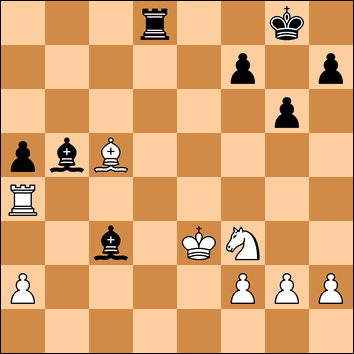
29. Ra3 Bb2
30. Rxa5 Bc1+
31. Ke4 Bc6+
32. Ke5 Rd5+
33. Kf6 Bb2+
Only 34. Bd4 stops an immediate mate. If 34. Ke7 then 34. ... Rd7+ 35. Ke8 and Black can choose between picking up the rook with 35. .. Ra7+ or forcing mate with 35. .. Kf6 so I resigned.
